

Compact Muon Solenoid
LHC, CERN
| CMS-PAS-FTR-18-014 | ||
| Vector Boson Scattering prospective studies in the ZZ fully leptonic decay channel for the High-Luminosity and High-Energy LHC upgrades | ||
| CMS Collaboration | ||
| December 2018 | ||
| Abstract: Prospective studies for the vector boson scattering (VBS) in the ZZ channel at the HL-LHC are presented, where the Z bosons are identified and measured through their leptonic decays, $\ell =$ e, $\mu$. The results obtained from the 2016 analysis with an integrated luminosity of 36 fb$^{-1}$ are projected to the HL-LHC luminosity of 3000 fb$^{-1}$ and center-of-mass energy of 14 TeV, taking into account the increased acceptance of the CMS detector. The projected uncertainty in the VBS ZZ cross section is 8.5-10.3% depending on the lepton $\eta$ coverage and assumptions made for the systematic uncertainties. A study is performed to separate the longitudinal polarization ($\mathrm{Z_L}$) from the dominant transverse polarizations. The expected sensitivity for the VBS $\mathrm{Z_LZ_L}$ fraction is 1.4 standard deviations. The foreseen upgrade coverage of up to $\vert \eta \vert = $ 3(2.8) for electrons (muons) leads to a 13% improvement in sensitivity compared to the Run 2 acceptance. Extending the coverage for electrons up to $\vert \eta \vert = $ 4 would result in a modest increase in the sensitivity. Finally, the HE-LHC option would allow to bring the sensitivity at the 5$\sigma$ level for this process. | ||
| Links: CDS record (PDF) ; inSPIRE record ; CADI line (restricted) ; | ||
| Figures | |
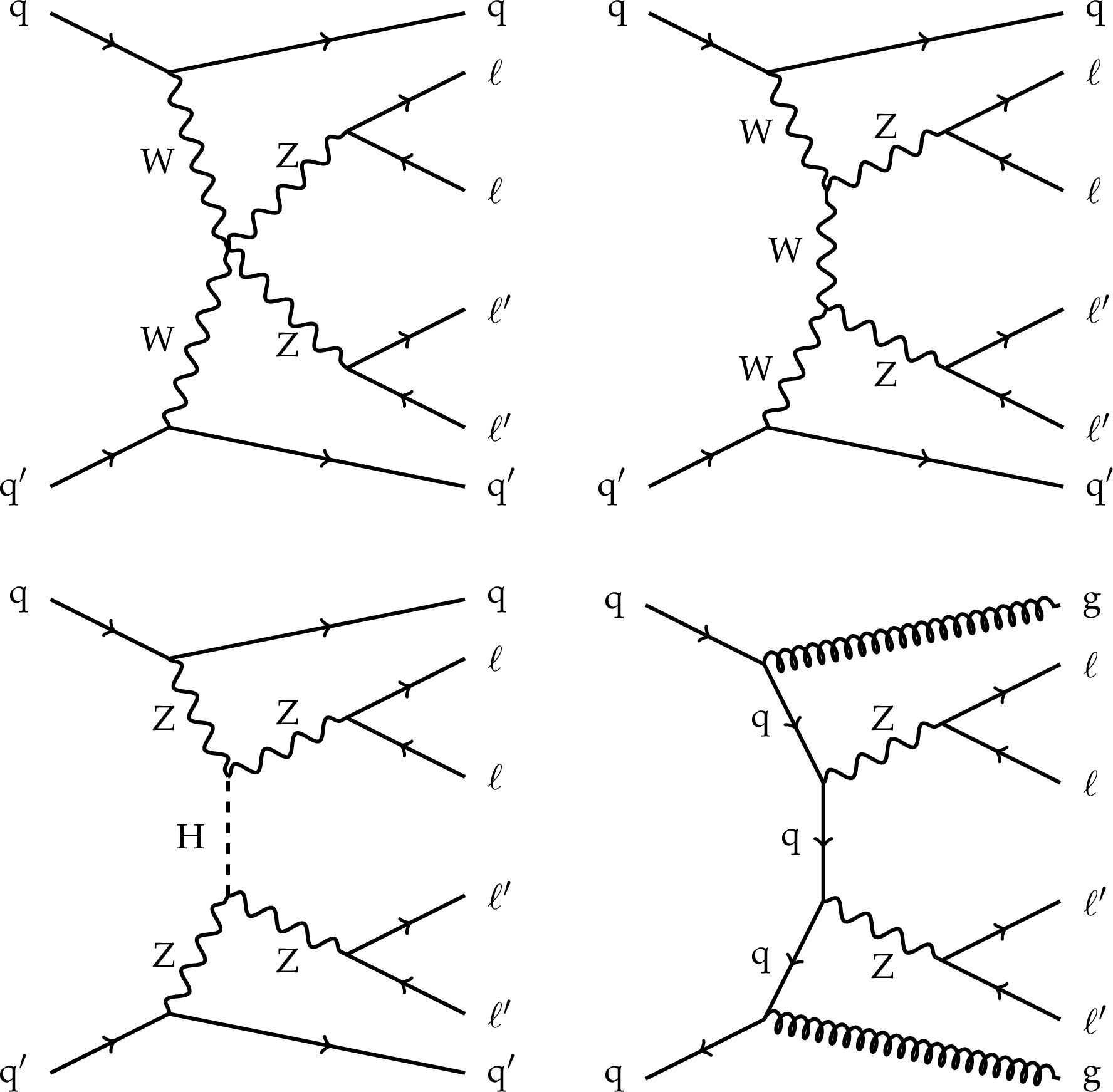
png pdf |
Figure 1:
Representative Feynman diagrams for the EW- (top row and bottom left) and QCD-induced production (bottom right) of the $ {\mathrm {Z}} {\mathrm {Z}} \textrm {jj}\rightarrow \ell \ell \ell ^{\prime}\,\ell ^{\prime} \textrm {jj}$ ($\ell,\, \ell ^{\prime}\,= {\mathrm {e}}$ or $\mu $) final state. The scattering of massive gauge bosons as depicted in the top row is unitarized by the interference with amplitudes that feature the Higgs boson (bottom left). |

png pdf |
Figure 2:
Expected distribution of the BDT output for 3000 fb$^{-1}$. The points represent pseudo data generated from the sum of the expected contributions for each process. The purple filled histogram represents the EW signal, the dark blue the QCD ggZZ background, the light blue the QCD qqZZ background, the yellow the ttZ plus WWZ backgrounds and the green the reducible background. |
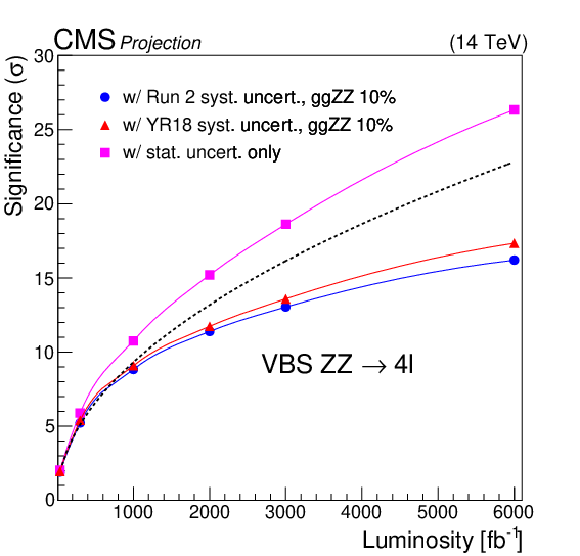
png pdf |
Figure 3:
Projected significance for a 10% uncertainty in the QCD ggZZ background yield as a function of the integrated luminosity and for all other systematic uncertainties according to the Run 2 scenario (blue line and circles), and according to YR18 scenario (red line and triangles). The magenta line and squares show the results with only the statistical uncertainties included. The dashed line shows the projected significance as obtained scaling the 2016 result with statistical uncertainty only by the luminosity ratio. |
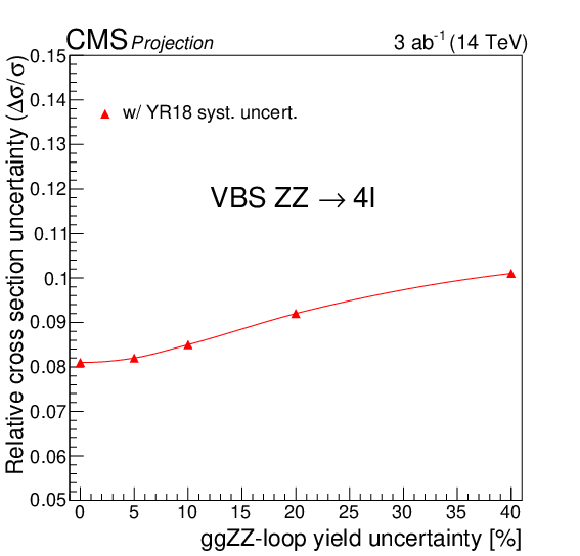
png pdf |
Figure 4:
Projected relative uncertainty in the cross section for 3000 fb$^{-1}$ as a function of the uncertainty in the QCD ggZZ background yield (right). The YR18 scenario is used for the other systematic uncertainties. |

png pdf |
Figure 5:
Projected relative uncertainty in the cross section as a function of the integrated luminosity and for all other systematic uncertainties according to the Run 2 scenario (blue line and circles), and according to the YR18 scenario (red line and triangles). Results are shown for 10% uncertainty uncertainty in the QCD ggZZ background yield. The magenta line and filled squares show the results with only the statistical uncertainties included. |
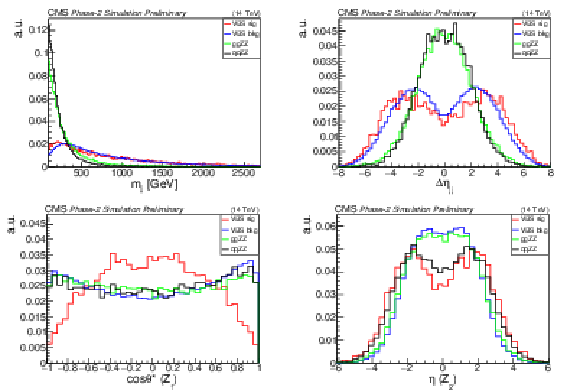
png pdf |
Figure 6:
Distributions of some the discriminant variables for the $\mathrm {VBS Z_LZ_L}$ signal, the $\mathrm {VBS Z_LZ_T}$ and $\mathrm {Z_TZ_T}$ background and the QCD backgrounds from Delphes simulation and for the ZZjj inclusive selection that requires $m_{jj} > $ 100 GeV. The distributions are normalized to unity for shape comparison. |

png pdf |
Figure 6-a:
Distribution of $m_{\text{jj}}$ for the $\mathrm {VBS Z_LZ_L}$ signal, the $\mathrm {VBS Z_LZ_T}$ and $\mathrm {Z_TZ_T}$ background and the QCD backgrounds from Delphes simulation and for the ZZjj inclusive selection that requires $m_{jj} > $ 100 GeV. The distribution is normalized to unity for shape comparison. |
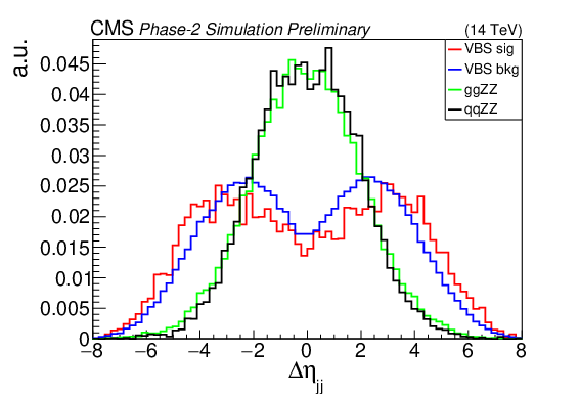
png pdf |
Figure 6-b:
Distribution of $\Delta \eta _{\text{jj}}$ for the $\mathrm {VBS Z_LZ_L}$ signal, the $\mathrm {VBS Z_LZ_T}$ and $\mathrm {Z_TZ_T}$ background and the QCD backgrounds from Delphes simulation and for the ZZjj inclusive selection that requires $m_{jj} > $ 100 GeV. The distribution is normalized to unity for shape comparison. |

png pdf |
Figure 6-c:
Distribution of $\cos{\theta^{*}}(Z_1)$ for the $\mathrm {VBS Z_LZ_L}$ signal, the $\mathrm {VBS Z_LZ_T}$ and $\mathrm {Z_TZ_T}$ background and the QCD backgrounds from Delphes simulation and for the ZZjj inclusive selection that requires $m_{jj} > $ 100 GeV. The distribution is normalized to unity for shape comparison. |
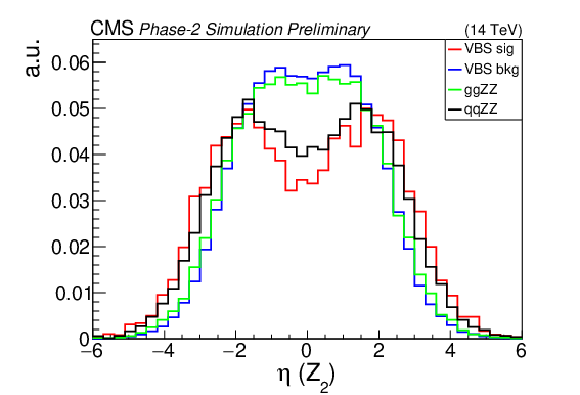
png pdf |
Figure 6-d:
Distribution of $\eta( Z_2)$ for the $\mathrm {VBS Z_LZ_L}$ signal, the $\mathrm {VBS Z_LZ_T}$ and $\mathrm {Z_TZ_T}$ background and the QCD backgrounds from Delphes simulation and for the ZZjj inclusive selection that requires $m_{jj} > $ 100 GeV. The distribution is normalized to unity for shape comparison. |

png pdf |
Figure 7:
Expected significance for the VBS $\mathrm {Z_LZ_L}$ fraction as a function of the integrated luminosity and for systematic uncertainties according to the Run 2 scenario (blue line and circles), and according to the YR18 scenario (red line and triangles). Results are shown for 10% uncertainty in the QCD ggZZ background yield. The magenta line and squares show the results with only the statistical uncertainties included. |
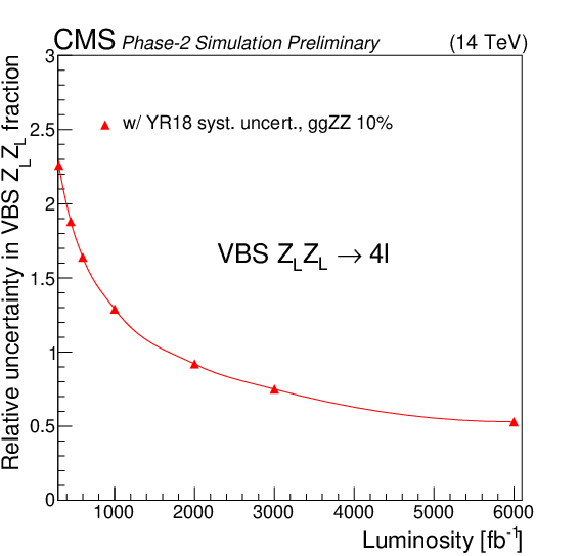
png pdf |
Figure 8:
Expected relative uncertainty in the VBS $\mathrm {Z_LZ_L}$ fraction as a function of the integrated luminosity and for systematic uncertainties according to the YR18 scenario. Results are shown for 10% uncertainty in the QCD ggZZ background yield. |
| Tables | |

png pdf |
Table 1:
Cross section ratios $\sigma _{14 TeV}$ / $\sigma _{13 TeV}$ and $\sigma _{27 TeV}$ / $\sigma _{14 TeV}$ for the EW signal and the QCD background processes. |

png pdf |
Table 2:
Acceptance ratios for the Phase-2 detector with respect to Run 2 for various $\eta $ coverage configurations. The first number denotes the cut value for electrons while the number in parentheses denotes the cut value for muons. The numbers are for the center-of-mass energy of 13 TeV. |

png pdf |
Table 3:
Effect of the systematic uncertainties on the signal and backgrounds yields for the two considered scenarios. |

png pdf |
Table 4:
Signal and background yields projections for the ZZjj inclusive selection used in the statistical analysis and for a VBS cut-based selection also requiring $m_{jj} > $ 400 GeV and $| \Delta \eta _{jj} | > 2.4$. Quoted uncertainties correspond to the systematic uncertainties for the Run 2 scenario together with a 40% uncertainty in the QCD ggZZ background yield, as used for the Run 2 analysis. |

png pdf |
Table 5:
Significance and measurement uncertainty in the VBS $\mathrm {Z_LZ_L}$ fraction for different lepton coverage configurations. The first configuration corresponds to the Run 2 configuration, the second to the Phase-2 upgrade and the third to an option for which the electron coverage would be extended up to $| \eta | = $ 4. In the quoted $\eta $ coverages, the first number corresponds to electrons, while the number in parentheses corresponds to muons. |

png pdf |
Table 6:
Expected significance and measurement uncertainty for the measurement of the VBS $\mathrm {Z_LZ_L}$ fraction at HL-LHC and HE-LHC, with and without systematic uncertainties included. |
| Summary |
|
We presented prospective studies for the vector boson scattering at the HL-LHC in the ZZ fully leptonic decay channel. The analysis is based on the measurement performed using data recorded by the CMS experiment in 2016. The results previously obtained are projected to the expected integrated luminosity at HL-LHC of 3000 fb$^{-1}$ at the center-of-mass energy of 14 TeV, taking into account the increased acceptance of the new detector for the leptons and considering two scenario for the systematic uncertainties. The projected relative uncertainty in the VBS ZZ cross section measurement is 9.8% (8.8%) for the Run 2 (YR18) scenario and for a 10% uncertainty in the QCD ggZZ background yield, for an integrated luminosity of 3000 fb$^{-1}$ and a coverage of up to $\vert \eta \vert = $ 3 for electrons. Extending the coverage up to $\vert \eta \vert = 4$ for electrons, the projected measurement uncertainty would be 9.5% and 8.5%, respectively. The sensitivity for the longitudinal scattering VV $\rightarrow \mathrm{Z_L}\mathrm{Z_L}$ is assessed. The VBS $\mathrm{Z_LZ_L}$ signal is separated from the VBS and QCD backgrounds by means of a multivariate discriminant that combines observables that discriminate VBS from QCD processes as well as observables that discriminate longitudinal from transverse Z boson polarizations. The expected significance for the VBS $\mathrm{Z_LZ_L}$ fraction is 1.4$\sigma$ for an integrated luminosity of 3000 fb$^{-1}$. With such integrated luminosity we enter measurement era for the VBS $\mathrm{Z_LZ_L}$ fraction, with relative uncertainty below 100%. The measurement of such rare processes will of course benefit greatly of the highest luminosities. The lepton pseudorapidity coverage foreseen for the CMS detector upgrade leads to a significant improvement of the significance and cross section uncertainty for the VBS $\mathrm{Z_L}\mathrm{Z_L}$ process. Extending the coverage for electrons up to $\vert \eta \vert = $ 4 would result in a modest improvement in the performance. Finally, the HE-LHC option would allow to bring the sensitivity at the 5$\sigma$ level for this process. |
| References | ||||
| 1 | CMS Collaboration | Measurement of vector boson scattering and constraints on anomalous quartic couplings from events with four leptons and two jets in proton-proton collisions at sqrt(s) = 13 TeV. | PLB 774 (Aug, 2017) 682--705. 24 p | CMS-SMP-17-006 1708.02812 |
| 2 | CMS Collaboration | Observation of electroweak production of same-sign W boson pairs in the two jet and two same-sign lepton final state in proton-proton collisions at $ \sqrt{s} = $ 13 TeV | PRL 120 (2018), no. 8, 081801 | CMS-SMP-17-004 1709.05822 |
| 3 | ATLAS Collaboration | Observation of electroweak production of a same-sign $ W $ boson pair in association with two jets in $ pp $ collisions at $ \sqrt{s}= $ 13 TeV with the ATLAS detector | ATLAS-CONF-2018-030, CERN, Geneva, Jul | |
| 4 | ATLAS Collaboration | Observation of electroweak $ W^{\pm}Z $ boson pair production in association with two jets in pp collisions at $ \sqrt{s} = $ 13TeV with the ATLAS Detector | ATLAS-CONF-2018-033, CERN, Geneva, Jul | |
| 5 | Ballestrero, A. and Maina, E. and Pelliccioli, G. | W polarization in vector boson scattering at the LHC | Submitted to | 1710.09339 |
| 6 | DELPHES 3 Collaboration | DELPHES 3, A modular framework for fast simulation of a generic collider experiment | JHEP 02 (2014) 057 | 1307.6346 |
| 7 | G. Apollinari et al. | High-Luminosity Large Hadron Collider (HL-LHC) : Preliminary Design Report | ||
| 8 | CMS Collaboration | The CMS Experiment at the CERN LHC | JINST 3 (2008) S08004 | CMS-00-001 |
| 9 | CMS Collaboration | Technical Proposal for the Phase-II Upgrade of the CMS Detector | CMS-PAS-TDR-15-002 | CMS-PAS-TDR-15-002 |
| 10 | CMS Collaboration | The Phase-2 Upgrade of the CMS Tracker | CDS | |
| 11 | CMS Collaboration | The Phase-2 Upgrade of the CMS Barrel Calorimeters Technical Design Report | CDS | |
| 12 | CMS Collaboration | The Phase-2 Upgrade of the CMS Endcap Calorimeter | CDS | |
| 13 | CMS Collaboration | The Phase-2 Upgrade of the CMS Muon Detectors | CDS | |
| 14 | CMS Collaboration | Particle-flow reconstruction and global event description with the CMS detector | Submitted to JINST | CMS-PRF-14-001 1706.04965 |
| 15 | CMS Collaboration | CMS Phase-2 Object Performance | ||
| 16 | J. Alwall et al. | MadGraph 5: going beyond | JHEP 06 (2011) 128 | 1106.0522 |
| 17 | NNPDF Collaboration | Parton distributions for the LHC Run II | JHEP 04 (2015) 040 | 1410.8849 |
| 18 | J. Alwall et al. | The automated computation of tree-level and next-to-leading order differential cross sections, and their matching to parton shower simulations | JHEP 07 (2014) 079 | 1405.0301 |
| 19 | R. Frederix and S. Frixione | Merging meets matching in MC@NLO | JHEP 12 (2012) 061 | 1209.6215 |
| 20 | T. Sjostrand, S. Mrenna, and P. Skands | Pythia 6.4 physics and manual | JHEP 05 (2006) 026 | hep-ph/0603175 |
| 21 | T. Sjostrand et al. | An introduction to PYTHIA 8.2 | CPC 191 (2015) 159 | 1410.3012 |
| 22 | CMS Collaboration | Measurement of the ZZ production cross section and $ {\mathrm{Z} \to \ell^+\ell^-\ell'^+\ell'^-} $ branching fraction in pp collisions at $ \sqrt{s} = $ 13 TeV | PLB 763 (2016) 280 | CMS-SMP-16-001 1607.08834 |
| 23 | D. Rainwater, R. Szalapski, and D. Zeppenfeld | Probing color singlet exchange in $ Z $+2-jet events at the CERN LHC | PRD 54 (1996) 6680 | hep-ph/9605444 |
| 24 | CMS Collaboration | Measurement of electroweak production of two jets in association with a Z boson in proton--proton collisions at $ \sqrt{s} = $ 8 TeV | EPJC 75 (2015) 66 | CMS-FSQ-12-035 1410.3153 |
| 25 | Y. Gao et al. | Spin determination of single-produced resonances at hadron colliders | PRD 81 (2010) 075022 | 1001.3396 |
| 26 | S. Bolognesi et al. | Spin and parity of a single-produced resonance at the LHC | PRD 86 (2012) 095031 | 1208.4018 |
| 27 | I. Anderson et al. | Constraining anomalous $ HVV $ interactions at proton and lepton colliders | PRD 89 (2014) 035007 | 1309.4819 |
| 28 | J. M. Campbell and R. K. Ellis | MCFM for the Tevatron and the LHC | NPB Proc. Suppl. 205-206 (2010) 10 | 1007.3492 |
| 29 | F. Campanario, M. Kerner, L. D. Ninh, and D. Zeppenfeld | Next-to-leading order QCD corrections to ZZ production in association with two jets | JHEP 07 (2014) 148 | 1405.3972 |
| 30 | M. Botje et al. | The PDF4LHC Working Group Interim Recommendations | 1101.0538 | |
| 31 | S. Alekhin et al. | The PDF4LHC Working Group Interim Report | 1101.0536 | |
| 32 | NNPDF Collaboration | Parton distributions for the LHC run II | JHEP 04 (2015) 040 | 1410.8849 |

|
Compact Muon Solenoid LHC, CERN |

|

|

|

|

|

|